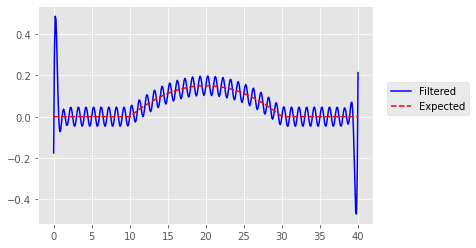I'm pretty well versed in statistics, but not really digital signal filtering. I have a data scenario where I expected to be able to pretty easily filter out some noise (human pulse) that's at a known frequency band, but I'm having a lot of trouble using the standard tools in the scipy.signal library and think I must be misunderstanding how to design digital filters. I have a notebook here that walks through my explorations thus far, but the gist is that the standard scipy filters seem to cause large distortions at the start and end of my signal, with the precise behaviour dependent on the phase of the noise signal I'm trying to subtract. Just in case the above binder link goes down, I'll include some of the key points below as well:
First generating some synthetic data that's similar to my real data:
#generate time vector
samples_per_sec = 10.0
total_time = 40.0
time = np.linspace(0, total_time, int(total_time*samples_per_sec))
#generate the pulse signal
pulse_hz = 1.0
pulse_phase = np.radians(0)
pulse = np.sin(time*(2*np.pi)*pulse_hz - pulse_phase)
#generate the BOLD signal (just something that goes up then down)
dist = stats.beta(2, 2)
bold = dist.pdf((time-10)/20) / 10.0 # division by 10 to make bold a small signal
#combine
pulse_plus_bold = pulse+bold
plt.plot(time, pulse_plus_bold);
Try a 1st order butterworth:
#1st order butterworth filter in ba mode
ba1 = signal.butter(
output = 'ba'
, N = 1 #needs to be low if using output='ba', else use output='sos' and sosfiltfilt
, Wn = [0.5,1.5]
, btype = 'bandstop'
, fs = samples_per_sec
)
filtered_ba1_nopad = signal.filtfilt(
b = ba1[0]
, a = ba1[1]
, x = pulse_plus_bold
, padtype = None
)
plt.plot(time, filtered_ba1_nopad, 'b');
plt.plot(time, bold, 'r--');
plt.legend(['Filtered', 'Expected'], loc=(1.04,.5));
First-order butterworth with even padding:
filtered_ba1_pad_even = signal.filtfilt(
b = ba1[0]
, a = ba1[1]
, x = pulse_plus_bold
, method = 'pad'
, padtype = 'even'
)
plt.plot(time, filtered_ba1_pad_even, 'b');
plt.plot(time, bold, 'r--');
plt.legend(['Filtered', 'Expected'], loc=(1.04,.5));
First-order butterworth with odd padding:
filtered_ba1_pad_odd = signal.filtfilt(
b = ba1[0]
, a = ba1[1]
, x = pulse_plus_bold
, method = 'pad'
, padtype = 'odd'
)
plt.plot(time, filtered_ba1_pad_odd, 'b');
plt.plot(time, bold, 'r--');
plt.legend(['Filtered', 'Expected'], loc=(1.04,.5));
This latter looks really good! But after playing around I discovered that whether odd or even (or either) padding works better seems to be contingent on the phase of the signal being filtered-out. As an example, while the above obtained excellent filtering with odd-padding, here's the same scenario but with a phase-shift added to the pulse signal that yields edge artifacts in both odd and even:
phase = np.radians(45)
pulse_shifted = np.sin(time*(2*np.pi)*pulse_hz - phase)
pulse_shifted_plus_bold = pulse_shifted+bold
filtered_shifted_ba1_pad_odd = signal.filtfilt(
b = ba1[0]
, a = ba1[1]
, x = pulse_shifted_plus_bold
, method = 'pad'
, padtype = 'odd'
)
filtered_shifted_ba1_pad_even = signal.filtfilt(
b = ba1[0]
, a = ba1[1]
, x = pulse_shifted_plus_bold
, method = 'pad'
, padtype = 'even'
)
fig, axes = plt.subplots(nrows=1, ncols=2, figsize=(5, 3))
axes[0].plot(time, filtered_shifted_ba1_pad_odd, 'b')
axes[0].plot(time, bold, 'r--')
axes[1].plot(time, filtered_shifted_ba1_pad_even, 'b')
axes[1].plot(time, bold, 'r--')
fig.tight_layout()
plt.title('Odd (left) and Even (right)')
plt.legend(['Filtered', 'Expected'], loc=(1.04,.5));
I've also tried the 'gust' padding method as well as higher order filters (using sos of course), and observe the same phase-dependent edge artifacts in everything I've tried. Any tips?





